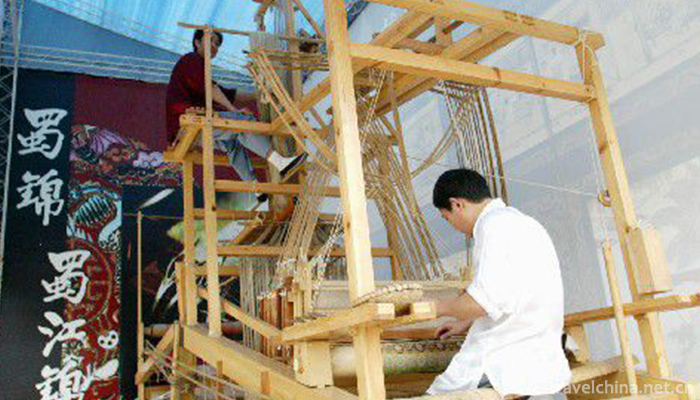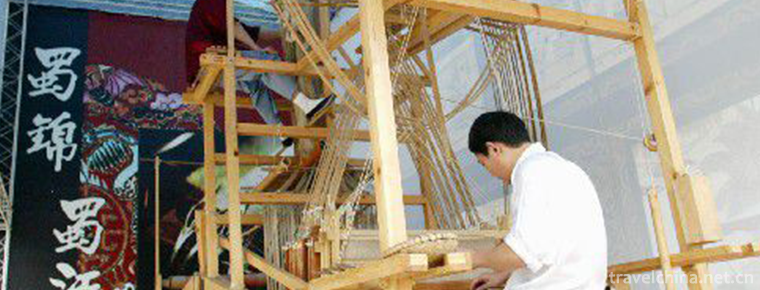Shu Brocade Weaving Techniques
Shu Brocade Weaving Techniques
Shu brocade weaving skills, the local traditional skills of Chengdu City, Sichuan Province, one of the national intangible cultural heritage.
Shu brocade weaving has a long history. The earliest written records were found in the reign of Huiwen King in the Spring and Autumn Period and Qin Dynasty. During the Warring States Period, Shu Brocade became an important trade product. It rose in Qin and Han Dynasty, flourished in Tang and Song Dynasties, declined in the late Ming Dynasty, recovered in the middle and late Qing Dynasty, and fell into crisis again in modern times. After the founding of New China, it gradually recovered.
On May 20, 2006, Shu brocade weaving technology was approved by the State Council and listed in the first batch of national intangible cultural heritage list. Item number_-16.
historical origin
Silkworm and mulberry civilization originated very early in Shu. Silkworm bushes, the first king in ancient Shu, were said to have taught people to raise silkworms. During the Spring and Autumn Period and the Warring States Period, Shangshu recorded that the brocade produced in Chengdu was called "Shu brocade" to show the difference.
By the Han Dynasty, the brocade industry in Chengdu became more and more prosperous, which led to the "harmony between machines" and the increasingly skilled weaving skills of Shu brocade, which was famous for its exquisite workmanship and various patterns. The weaving of Shu brocade in the Han and Tang Dynasties was mainly based on multi-faceted and multi-creep looms. When Zhang Biao of the Han Dynasty went to the Western Regions, he saw that the local businessmen preferred a kind of brocade. Zhang Biao looked at it and it turned out to be the Shu brocade of Chengdu. Yang Xiong, a Chengdu native of Shujun County in the Han Dynasty, wrote in Fu of Shudu: "If you wield rich cloth and embroidery, you will never see much. He is a man who makes his own wonderful brocade. Prosperous writing and endless generations."
The early Shu brocade was mainly composed of multiple warp silk blossoms (Jingjin), and the variety became more and more abundant after the Tang Dynasty. The patterns of Shu brocade in Tang Dynasty are checkered flower, lotus flower, tortoise shell flower, couplet beads, birds and animals, etc., which are very rich. At the end of the Tang Dynasty, designs such as Tianyue, Chang'an Bamboo, Fangsheng, Yiman, Lion Club and Badayan were added. Tang Xuanzong Li Longji took refuge in Shu. Soldiers complained. Tang Xuanzong restored morale with 100,000 pieces of Shu brocade.
During the Song and Yuan Dynasties, weft brocades with flowering weft were developed. The patterns of weft brocades were Qingfeng Nianjin, Lantern Brocade, Pan Ball, Cuichi Lion, Lark, Ruichao Yunhe, Baihua Peacock, Yimen Baihua, Ruyi Peony, etc. Lu Dafang set up Jinyuan in Chengdu in Song Dynasty. Similar to Jinguancheng, it is also a national Shu brocade factory responsible for the production of Shu brocade in Chengdu. In Song Dynasty, Chengdu was responsible for 670,200 Shu brocades, 7865 Shu brocades and almost all of the superior Shu brocades.
In the late Ming Dynasty, Shu brocade was destroyed. At this time, the patterns of plum, bamboo, peony, grape, pomegranate and so on.
After the Qing Dynasty, Shu brocade was restored. Affected by brocade weaving in the south of the Yangtze River, Yuehua brocade, Fangfang brocade and raccoon brocade were produced, among which Yuehua brocade and Yuehua brocade with color halo stripes were the most distinctive.
Modern Shu brocade is woven with dyed ripe silk, which has a tough texture and bright colors.
Inheritance and Protection
Inheritance value
Shu brocade is the symbolic skill of Chengdu. Chengdu has gained the reputation of "Jincheng" and "Jinguancheng" with its rich brocade. Minjiang River surrounds Chengdu, Shu Jinzhong is in the river, so Minjiang River is also called "Jinjiang". Shu brocade is rooted in Shu culture and has distinct regional characteristics. As early as the Qin and Han Dynasties, Shu Brocade had gone out of Sichuan and entered minority areas, contributing to economic development, social stability and national unity. As a carrier of cultural exchange and trade, it has witnessed history and unique cultural value in the world-famous "Silk Road" between North and South.
Current situation of inheritance
After the founding of the People's Republic of China, Shu Brocade had once been brilliant, but with the progress of industrialization, manual looms were gradually replaced by modern looms, showing a shrinking and declining trend. It is urgent to take effective measures to ensure the inheritance of Shu Brocade.
Heritage figures
Ye Yongzhou, male, was born in November 1929. On June 5, 2007, he was selected as the representative successor of Shu Brocade Weaving Technology, a national intangible cultural heritage project. Chengdu City, Sichuan Province, declared that the project name: Shu brocade weaving skills. The first batch of representative successors of national intangible cultural heritage projects.
protective measures
In 2013, four loom models were unearthed from Laoguanshan Han Tomb in Tianhui Town, Chengdu. In 2015, the Chinese Silk Museum and Chengdu Museum jointly restored the Han Dynasty loom according to the appropriate proportion of the unearthed loom models. In order to "revive" the brocade weaving skills of the Han Dynasty, the Chengdu Museum invited Wang Junping to lead his team to carry out further repairs, adjustments and experiments. Several sets of patterns were successfully weaved and the brocade scene of more than two thousand years was reproduced.
The Shu Brocade Museum reproduced six wooden machines of Shu Brocade Flower Building on the basis of an ancient Shu Brocade Machine in Daoguang Period of Qing Dynasty. It also invited the former chief engineer of Chengdu Shu Brocade Factory and seven veteran artists who had engaged in brocade weaving for decades to recruit a group of young apprentices from remote rural areas and carry out the teaching of Shu Brocade skills, which ensured that the whole weaving process continued to use the most essential, authentic, complete and most complete. Traditional Shu brocade weaving techniques. The personal data database of Shu brocade, Shu embroidery and other artists has also been established. Through the continuous recruitment of apprentices and apprenticeships, the old artists have carefully taught and guided apprenticeship, and have trained more than a dozen Shu brocade apprentices with an average age of 25 years.
social influence
Important Exhibitions
On January 23, 2017, the "Splendid Tianfu - Shu Brocade and Shu Embroidery Culture Exhibition" opened at Sanxingdui Museum in Guanghan, Deyang, Sichuan Province. The exhibition, as one of the "Sanxingdui Grand Sacrifice Activities", was opened to the public from January 23 to February 12. The event aims to promote Sichuan's long-standing "silk" culture, highlight the historical position of Sanxingdui as the starting point of the ancient southern Silk Road, and show the cultural charm of Shu brocade and Shu embroidery.
On June 22, 2017, a special exhibition ceremony was held at the Shujiang Brocade Court and Shu Brocade Embroidery Museum in Chengdu. The special exhibition, with the theme of "Wenming", aims to express that Shu Brocade is another reflection of people's living and thinking state. The exhibition showcases the representative styles of Shu brocade from the Spring and Autumn Period to the Warring States Period, including the fragments of Shu brocade from Sui, Tang and Ming and Qing Dynasties, and brocade weaving by workers on site.
On September 20, 2015, the Southern Silk Road Map by Ma Dekun and Hu Xueqiang revived the ancient Shu brocade weaving skills such as the gradual change of color warp for the first time at the invitation exhibition of innovative works by non-survivors in Sichuan Province. More than 100,000 visitors visited the exhibition.
Honorary recognition
Shu Jin's Southern Silk Road Map is a collection of two invention patents, the "combination of rich and beautiful" and the "gradual change of color classics", which won the "Best Creative Award" at the 5th China International Copyright Exposition.


-
1.Old Beijing fried Morchella
The most famous famous food in Beijing is old Beijing tripe and Beijing roast duck. As for the oldest and most prosperous snacks in Beijing, belly burst is definitely the best among them.
Time 2018-10-27 -
2.Dajiaowan Scenic Area Hailing Island Yangjiang
Dajiaowan Scenic Spot of Hailing Island in Yangjiang, located in Zhapo Town of Hailing Island in Yangjiang City, Guangdong Province, is a famous national AAAAA tourist attraction
Time 2018-12-12 -
3.Shangrao Lingshan Scenic Area
Shangraolingshan Scenic Area, located in the north of Shangrao County, Shangrao City, Jiangxi Province, is a national scenic spot with an area of 160 square kilometers. Lingshan is listed as the "
Time 2018-12-19 -
4.Xianguding Scenic Spot
Xianguding, located in the south of Huancui District, Weihai City, is only five kilometers away from the city centre. It is the highest peak in the Northwest Mountain of Wangdao, with an elevation of
Time 2018-12-22 -
5.Baiyundong Tourist Area Kongshan
Baiyundong in Kongshan Mountain is a national key scenic spot, National Geological Park and national AAAA level scenic spot. Located in Lincheng County of Xingtai City
Time 2019-01-29 -
6.Leiqiong Haikou Volcanic Group World Geopark
Leiqiong Haikou Volcanic Group World Geopark is located in Shishan Town, southwest of Haikou City. It is only 15 kilometers away from the urban area. The Expressway
Time 2019-01-29 -
7.Zaozhuang Old Street Shuicheng South Shandong
Shuicheng Zaozhuang Old Street in Southern Shandong Province is located in the middle section of Xichang Road in the Central District of Zaozhuang City, Shandong Province.
Time 2019-02-06 -
8.Shaman Dance of Ewenki Nationality
Shaman dance of Ewenki nationality is a traditional dance of Ewenki nationality. It is a national cultural heritage of China and is spread in Genhe region of Inner Mongolia Autonomous Region.
Time 2019-04-28 -
9.Making Techniques of Pickled Vegetables
Making pickles, the traditional skills of Beijing Liubiju Food Co., Ltd., is one of the national intangible cultural heritage.
Time 2019-05-06 -
10.Jin Opera
Jin Opera is Shanxi Bangzi, an important drama in northern China, also known as Zhonglu Opera, Chinese traditional opera. It was named after Fenyang, Xiaoyi, Qixian, Taigu and Taiyuan, which sprang up
Time 2019-05-07 -
11.King Yalu
King Yalu is the first long Miao heroic epic in history. It is usually chanted at the Miao spiritual ceremony. It is only handed down orally and has no written record. The history of the Miao people's
Time 2019-07-10 -
12.Safety production in Leshan
By the end of 2018, there were 81 production safety accidents in Leshan City, with 73 deaths and a direct economic loss of 19.0522 million yuan. Among them, there was one major accident and no major or above production safety accident. In 1132 traffic
Time 2020-12-17